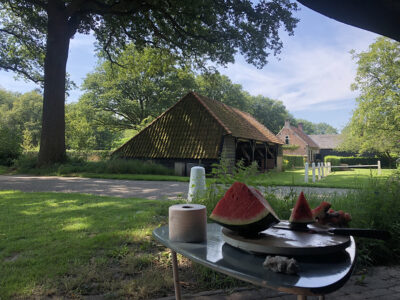14 October 2024
Interview
Humanity is always in transit, Samuel Sarmiento
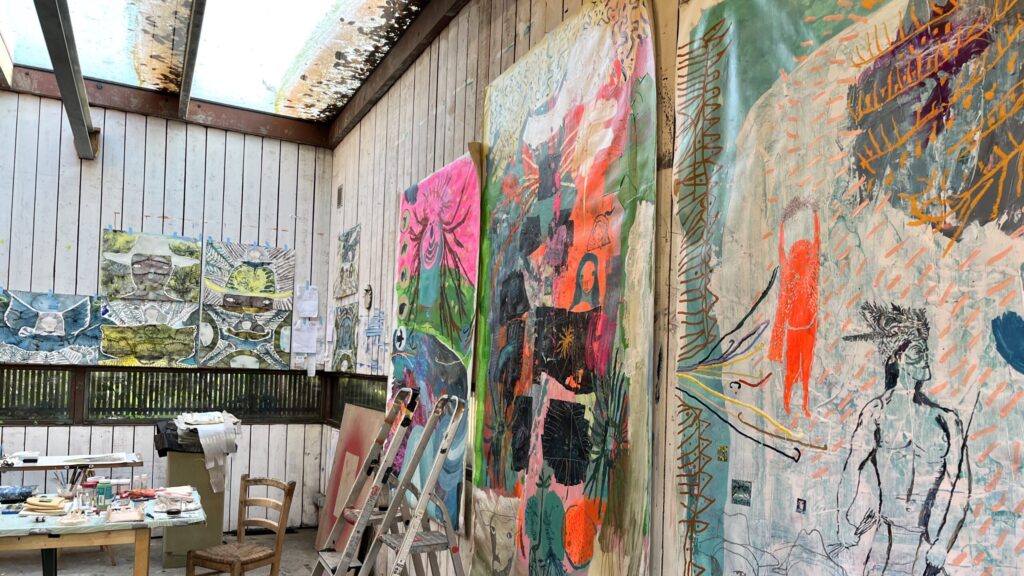
Artist Samuel Sarmiento was born and raised in Venezuela, but the political dynamics in his country made his family decide to move abroad. When he was invited to stay in Aruba, he thought it will be for a short time. Meanwhile ten years have passed, and he is still a resident of this small Caribbean Island, but always in transit because working as a professional artist he needs to travel and connect himself with the art scene abroad. That brought him earlier to EKWC (European Ceramic Work Centre) in Oisterwijk NL, where he gave a follow up to his first experience with ceramics during a Residency in ‘a tough neighborhood’ in South America. The Dutch soil however made impact, and he set out for a new challenge by exploring the connection between Caribbean painting and Vincent van Gogh during a residency in Zundert.
You arrived here, fresh from Aruba on October second, how was your first impression? What was your idea to start with?
I was really tired when I arrived here, but I soon began to work with ceramics because the clay has to dry. Meanwhile I started drawing and painting. However, it is very difficult to make your own works here and concerning the legacy of Vincent. He is everywhere in Zundert. For me visiting the south of the Netherlands is interesting because I found a lot of religious symbols here that I also know from Latin America. But I am not talking about religion; I am talking about images. Concerning Vincent I wanted to depict an unusual topic in his visual language, and I found a painting of him with an angel. I want to play with this angel character because I am a big fan of oral tradition and Caribbean stories. In my opinion it is interesting because when there is a significant change in human history, unusual characters appear as a representation of something giant coming. I am also a big fan of Carl Gustav Jung, the idea of the masks and persons. Some say angels use masks to talk to the people because what angels really look like is not comprehensible for humans, therefore they are depicted in a most serene way.
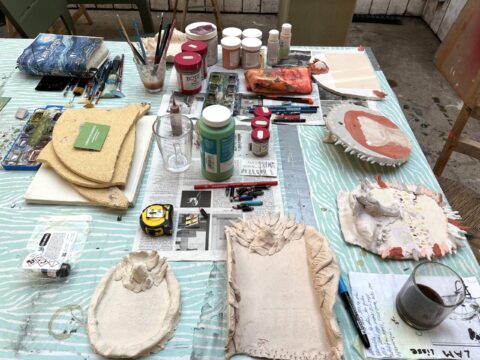
Photo by Esther van Rosmalen
I can recognize angel characters in some of the drawings, but there seems to be a change of strategy, what happens there?
The composition in most of the drawings I made is about eyes, and with the form of a mask. Then I thought that I did enough angels. I found out about the Japanese inspired paintings of Vincent based on Japanese woodprints. He also added some sort of framing by means of Japanese characters and decoration in the painting. So, I used that aspect in my own version, but I do not know Japanese writing, so I made waves as a framing around the story. Also, I made a drawing of the bridge with an angel face; a different composition then the original. After that I went to a different direction and experimented some more, and there Vincent came back in sight. The experiment is about the ‘Starry Night’ painting. The wind in this painting is very aggressive, I like that and combined that with other elements of myself and Vincent. Then I decided to continue with my own narrative; when Dutch sailors went to sail all over the world, they brought exotic birds to Europe. I talk about the seventeenth century. The story is that they cut of the legs of the bird to able to tell that these birds are different, that they always fly and never rest. So, I depicted this idea also.
You also made very small works on postcard size, has that also something to do with traveling?
The organizers of this residency, Ron and Eva*, collaborate with an Artist in Residence in Japan. Vincent had a big desire to visit Japan to study the light and the landscapes. With that in mind I decided to make a sort of series of postcards where Vincent might have visited. Like for example Russia, there was here a book of the Kremlin, so I made a sort of painting of the size of a postcard like it was from his hand. Also, Egypt with a pyramid and one with birds and the other with a camel. And in my fantasy, he even made a small visit to the Caribbean where he made landscapes from his visits to the islands. And he also went to Japan, but in the sixties of the last century, so Godzilla is the protagonist in his souvenir picture.
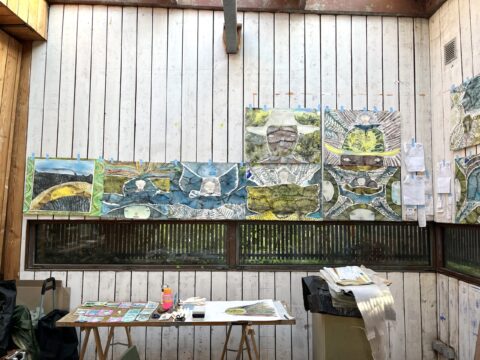
Photo by Esther van Rosmalen
And how about the ceramics, what was your plan for that?
A residency of a month is very short; I decided to work on ceramics, drawings and paintings simultaneously. I planned how to work with clay in these few weeks, but the real problem is the drying time. If I start firing too fast, in my experience, the piece breaks when it comes out of the ceramic kiln. I also brought some of the ceramics with me that I made earlier at EKWC. Here you see a ceramic with a Vincent talking with artist Wilfredo Lam depicted in two illustrations. You see the chair that Vincent painted, and the version Wilfredo made of that painting. In my view, this artwork is an imaginary meeting where they met and discuss the way of depicting this. It’ s fascinating how both artists used a daily life object, a chair, as inspiration on different periods of art history.
You use ceramics, but they are still a sort of canvas and, besides the sculpture of the crown, not an object. Why?
The crown is indeed different; mostly I use ceramics as a container. On paper I paint random idea’s but on ceramics I put ideas. For me it is a canvas, but it is a particular canvas. I also like to write on my pieces of ceramics, and I always depict something on the back of it. It is like a secret or an easter egg; it is like a portret, the idea of something behind the work you are looking at. This face could be a mask, but I also need to discover what it is. For me ceramics is a way to relate to different forms of telling the story in another way. Besides my interest in history, I use it in a way to talk of history. And I live on an island with hot and humid weather that can damage paper, but not clay.
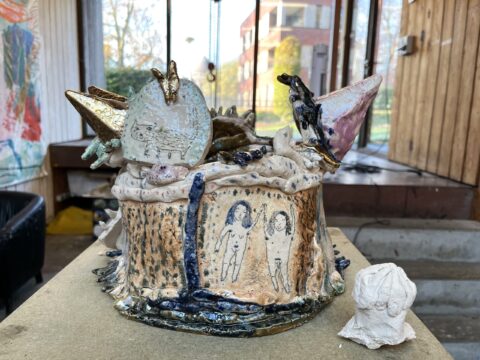
Photo by Esther van Rosmalen
You live in Aruba now, why is that?
Before I lived in Maracaibo, a big city in Venezuela near the coast. In the seventies it was a good place to live in, a lot of oil export, but now it is all destroyed by communists. As a result, my family went to all sort of places around the world. Some of them went to Colombia, Mexico and Chile; other went to Aruba. Some relative asked me to stay at this Island for a few months but I never left. I like it, but not for the art scene. The primary industry on the islands is tourism, so everything is connected to that. Most of the Aruban art is a happy version of life on the island. That is a problem if you want to do something else as an artist, if you want to grow in your practice…
I think it is necessary to visit different places to develop a universal artistic language. Therefore, I go to Artist in Residencies and look for new projects or collaborations because there are not enough opportunities at such a small island as Aruba. And there is also the fact that I am not from here; I am a foreigner. But humanity is always in transit, people move around the globe. In small places there is an idea of 100% local, and it’s dangerous because there is a thin line between pride of your hometown, autarchy and nationalism. So, traveling and encounter different point of view is essential for artists. Therefore, I am also very interested in Mercator projection. Not only because of the mapping system, but also because of the narrative and how artists can create new visions of reality and human relations. In this age the center is everywhere. The center is also the relevance where society moves from.
And now being here, is your opinion of Vincent changed?
I prefer to see him as a person, not as an artist. He also moved to different countries. It made me see his life as a human being and I feel closer to him as to any other artist. Before I saw him as a sort of mythical figure, but now I perceive Vincent’s life is an archetype; it is sad, and his work was not appreciated. He painted very aggressive landscapes with a lot of volume. And his mental issues… Being here, surrounded by the religious context of his youth feels like he is pushed into a difficult situation and sadness.
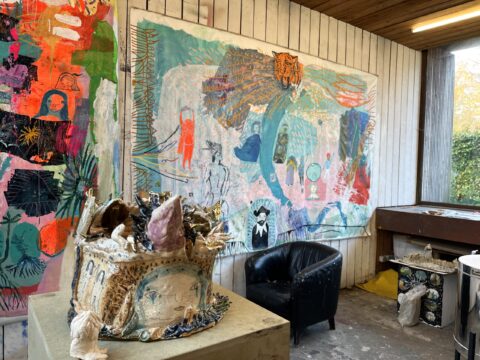
Photo by Esther van Rosmalen
Have you made new discoveries in your work?
Yes, every day in my painting. I choose other topics, I try to enjoy that the weather and light are different, which results in another choice of color. After the clay and the drawing, I decided to work on some painting. I am also a big fan of Alexander von Humboldt. He researched the nature of Latin America but did not want to own the land like explores mostly do. So, I made Vincent here to exchange with different cultures by putting his portret in the paintings. A few days ago, one of the neighbors came in and talked about the Corso – the big festival here with Dahlia’s – and how a tiger just like I painted was there but made of flowers. I combined all sort of things, a small landscape of Vincent in the middle of the paintings as a sort of proof that Vincent is everywhere. For example, I depicted a man from here on a scootmobil and I painted a sticker of Vincent on it. But more practical, I also played here with the colors and the materials because the air is different and has influence on the drying time of the acrylic paint. There is a great difference between the Caribbean in climate and in life. We just continue living, we love to do what we do. It’s the passion.
* Ron Dirven is the director and Eva Geene curator at the Van Gogh AiR.

